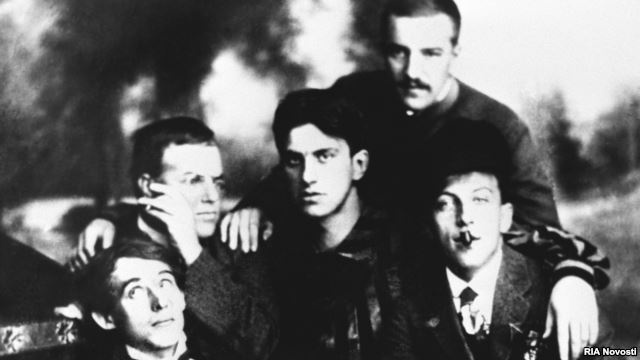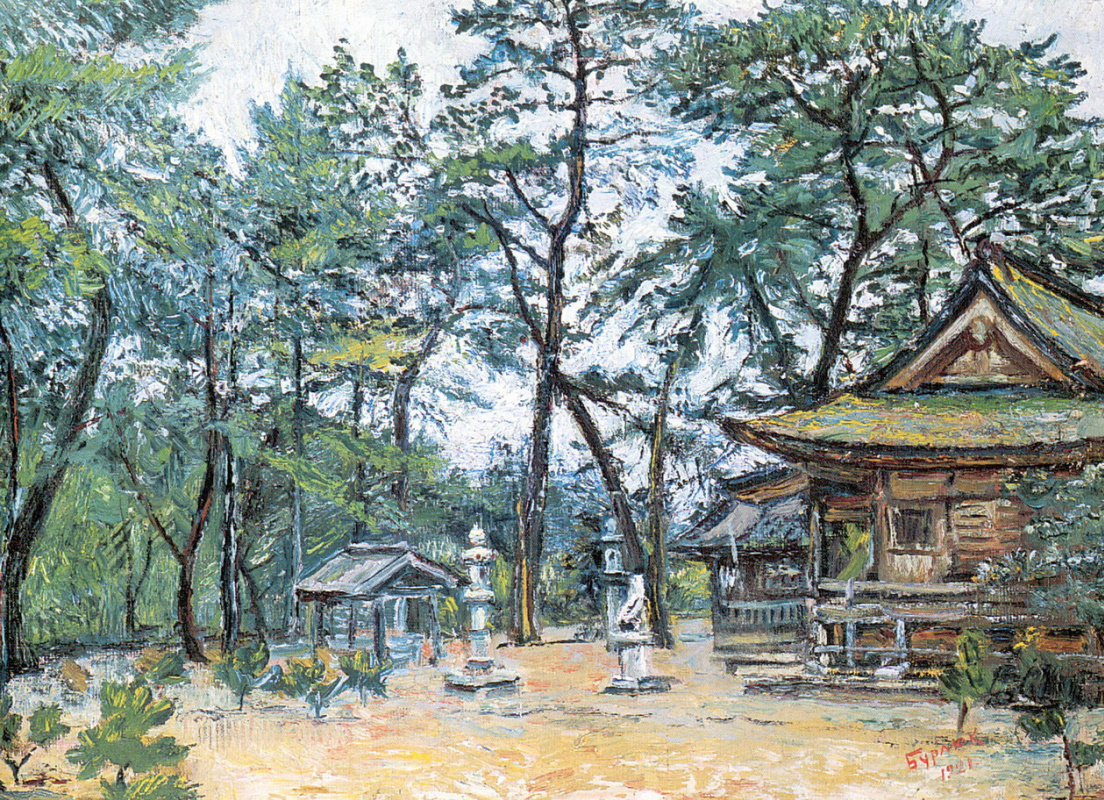If the "father of Russian futurism" appeared at an art get-together these days, he would have made a splash both with his appearance (steampunk?) and shocking behaviour. His creativity had the same features! Mayakovsky himself followed him! Of course, "the big stormy Burliuk bursts into life" with all the energy of his irrepressible nature.

Alexei Kruchyonykh:
"Big stormy Burliuk bursts into life. He is wide and greedy. He needs to learn everything, capture everything, devour everything. A complex figure."Mayakovsky was his student.
It is about Burliuk that he wrote his strange poems, where he called him "a fat man with a torn eye". But in fact, Mayakovsky admired Burliuk, like everyone around him. His memories about Burliuk also resemble poetry: "Burliuk appeared at the school. The look is arrogant. Lorgnette. Jacket. Goes humming. I began to bully."Fate seemed to prepare the role of a public peace breaker for the future "father of Russian futurism" from the very beginning, even from the moment in childhood, when after a fight with his brother, by an absurd accident he lost his left eye. And this is how Burliuk was imprinted in the memory of his contemporaries: with a glass eye, with a horse tattooed on his cheek, and with an earring embroidered with beads in one ear. Stylish, bohemian and shocking!
However, the appearance of David Burliuk was only a reflection of his restless inner world, filled with the creative energy, which he generously shared with others. He had an incredible social temperament and heightened sense of modernity. And these qualities placed him at the very centre of artistic life at the beginning of the last century.
However, the appearance of David Burliuk was only a reflection of his restless inner world, filled with the creative energy, which he generously shared with others. He had an incredible social temperament and heightened sense of modernity. And these qualities placed him at the very centre of artistic life at the beginning of the last century.
Let’s just try to list the unspoken titles and regalia of the artist: the famous painter and graphic artist, writer and poet, the "father" of Russian futurism
and cubo-futurism
, the initiator of revolutionary ideas in art that united such iconic figures as Mayakovsky, Kamensky, Kruchyonykh, Matyushin, Khlebnikov, Lentulov, Guro, Aseev, Exter, Tretyakov. The initiator of the first Russian futurist literary and artistic association within the Gilea group, one of the organizers of the Jack of Diamonds and Wreath — Stefanos innovative associations, a member of The Union of Youth society and the Munich Blue Rider — just imagine the scale of his feverish activity!
"Big stormy Burliuk bursts into life. He is wide and greedy. He needs to learn everything, capture everything, devour everything. A complex figure", Alexei Kruchyinykh wrote about him. For he was not afraid to give "A Slap in the Face to Public Taste" — that was the title of the first poetry collection of the Cubo-Futurists of 1912, among the authors of which were Burliuk, Khlebnikov, Mayakovsky.
"Big stormy Burliuk bursts into life. He is wide and greedy. He needs to learn everything, capture everything, devour everything. A complex figure", Alexei Kruchyinykh wrote about him. For he was not afraid to give "A Slap in the Face to Public Taste" — that was the title of the first poetry collection of the Cubo-Futurists of 1912, among the authors of which were Burliuk, Khlebnikov, Mayakovsky.

These words express the essence of the relationship between Burliuk and Mayakovsky: "A wonderful friend. My real teacher. David made me a poet. He read French and Germans to me. Gave me books. He gave me 50 kopecks every day so that I could write without starving."
Photo: Nikolai Burliuk, David Burliuk, Vladimir Mayakovsky, Benedikt Livshits and Alexei Kruchyonykh (at the very bottom). 1911.
Photo: Nikolai Burliuk, David Burliuk, Vladimir Mayakovsky, Benedikt Livshits and Alexei Kruchyonykh (at the very bottom). 1911.
The future artist, poet, prose writer and futurist was born in Ukraine, in Semyrotovschyna hamlet, Kharkiv Governorate, on 9 July 1882. He studied a bit of everything around the world. He mastered painting both in Russian Empire
(art schools of Kazan and Odesa) and abroad (private studios in Munich, Paris, Bavaria). Since the 1910s, he has become known to Russia and Europe as the leader and theorist of Russian futurism
. Since 1915 he moved to Bashkiria, since 1918 he travelled in the Urals, Siberia, the Far East.
In 1920, Burliuk emigrated first to Japan, where he introduced his ideas of futurism and absorbed Japanese culture, then two years later to the United States. There he remained forever, visiting Havana during the winter and arranging exhibitions there. Burliuk only visited the USSR twice — in 1956 and in 1965. Despite his acute desire to be published in the Union, he was not able to print a single line. He was not accepted in communist Russia — they called him a "convoy bastard" and "renegade", his name was consigned to oblivion. While at this time he managed to draw a huge number of paintings and become famous throughout the world, though suffering from nostalgia for his homeland.
In 1920, Burliuk emigrated first to Japan, where he introduced his ideas of futurism and absorbed Japanese culture, then two years later to the United States. There he remained forever, visiting Havana during the winter and arranging exhibitions there. Burliuk only visited the USSR twice — in 1956 and in 1965. Despite his acute desire to be published in the Union, he was not able to print a single line. He was not accepted in communist Russia — they called him a "convoy bastard" and "renegade", his name was consigned to oblivion. While at this time he managed to draw a huge number of paintings and become famous throughout the world, though suffering from nostalgia for his homeland.
Temple gate in Japan
1921
David Burliuk died on 15 January 1967 in Hampton Base (USA). According to the will, his ashes were scattered over the waters of the Atlantic.
Collections of the artist’s paintings are kept in the museums and private collections all over the world. Indeed, the multifaceted work of such an iconic artist is known to the whole world today; and, of course, Ukraine is deservedly proud of its such a flamboyant and extraordinary son.
Collections of the artist’s paintings are kept in the museums and private collections all over the world. Indeed, the multifaceted work of such an iconic artist is known to the whole world today; and, of course, Ukraine is deservedly proud of its such a flamboyant and extraordinary son.
Japanese sowing rice
1920, 60.5×44.5 cm














